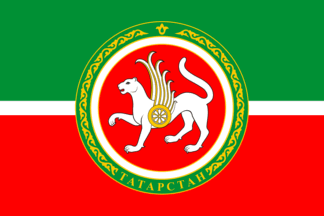 image by Tomislav Šipek, 7 December 2019
image by Tomislav Šipek, 7 December 2019
Last modified: 2021-07-24 by valentin poposki
Keywords: tatarstan |
Links: FOTW homepage |
search |
disclaimer and copyright |
write us |
mirrors
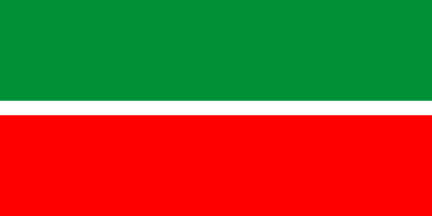 image by Tomislav Šipek, 7 December 2019
image by Tomislav Šipek, 7 December 2019
(Note: You need an Unicode-aware software and font to correctly view the Cyrillic text on this page. See here transliteration details).
Tatarstan is peopled by both Russians and Tatar peoples. The latter trace
their heritage to the powerful Kazan state which was finally conquered by the
Russian Tsar Ivan the Terrible in 1552. A Tatar ASSR was established early in
the history of the USSR, in 1920. The Tatars were supposed to form an
ideological spearhead for the communization of other non-Slavic peoples. In
1990, this ASSR declared itself a full Union Republic (being amongst the first
to do so). In 1992, the Republic passed, by referendum, a resolution of
independence. Since then, however, the constitutional crisis this posed appears
to have been defused, with the signing of a unique accord between Russia and Tatarstan defining mutual roles and obligations.
Stuart Notholt, 25 Nov 1995
Tatars as a nation originated as a result of mixing of Turkic tribes that
came from Asia to what is now Tatarstan in the 7th century AD with local
Finnish tribes that lived there.
Tatars created their own state in the 9th century AD in what is now
Tatarstan. It was one of the first states in Eastern Europe (it came into
existence earlier than Russia).
Sabirzyan Badertinov, 01 Jul 1997
As far as I know, there’s currently no especially active Tatar
independentist movement, although is clear that Tatars are the
most different and proud of all peoples in Russia — they’re
also the largest all-Russia minority ethnical group, after Russian and Ukrainian.
António Martins, 08 Apr 1998
The flag officially adopted on 29 November 1991 holds
red and green in a 7:1:7 three horizontal stripes.
Giuseppe Bottasini
This flag (but in proportions 2:3)
is listed under number 92 at the chart Flags
of Aspirant Peoples [eba94] as:
«Tatarstan (Tatars) - Central Russia».
Ivan Sache, 15 Sep 1999
The colours
purportedly stand for the Muslim Tatars and the Russians.
Stuart Notholt, 25 Nov 1995
According to official explanation:
The colours of the national flag of Tatarstan,
were designed from the flag of the Tatar Public Center,
(which was planned to be the new national flag)
later recognized by the Tatarstan
Constitution as the flag of the
Turkish peoples of
Idel-Ural.
Jaume Ollé, 21 Oct 1997,
and Ralf Stelter, 04 Mar 1999
According to Rezeda Dautova [dtv01],
the flag of Tatarstan was designed by artist-painter Tavil Qazâqmatov
(Тавил
Хазяхматов)
in 1986, during his stay in England; he made many proposals for the future
flag. In 1991 a competition for Tatarstan flag and arms was
held and one of Qazyaqmatov’s designs was chosen among more than 100 proposals,
and was adopted in 1991 by the Tatarstan parliament.
(Interesting fact is, that Khazyakhmatov and Fakhrutdynov, the
arms competition winner received as award
only middle-class cars Oka. In Bashkiria,
winners of competition for arms and flag received top-class cars Volga
and three-room flats.)
Grzegorz Skrukwa, 15 Oct 2001
My sources say "Qazâqmetov"
(Хазяхметов).
Victor Lomantsov, 15 Oct 2001
I’m just back from four days in Nabereẑnyĭ Ĉelny,
in Tataria (a city briefly named Breẑnev in the last years of the soviet
era). The Tatar flag is widely used locally, either isolated or along with the
Russian national flag. It seemed to me that standalone flags are
usually longer (1:2) and those flown along with the Russian flag shorter
(2:3), but that might have been an optical illusion due to the narrow middle
stripe. No other flags in sight, except for commercial flags, like oil
companies’ at gas stations.
António Martins, 09 Mar 2000
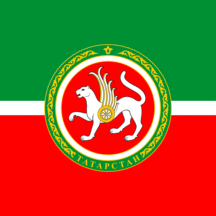
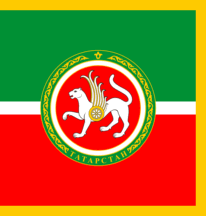 images by Tomislav Šipek, 7 December 2019
images by Tomislav Šipek, 7 December 2019The simplest variants of
standards are accepted in Republics. This
imposing of the arms on a national flag.
Such symbols have heads of Republic Tatarstan.
Sergey Filatov, 10 Oct 2005
Most of these flags are squarish (about 11:12),
rigid and fringed variants of the region (Governors) or Republic (Presidents)
flags with the regional emblem over all.
António Martins, 02 Oct 2005
Source of flags above:
http://protatarstan.ru/
Tomislav Šipek, 7 December 2019
.gif) image by Pascal Gross, 21 Jan 2000
image by Pascal Gross, 21 Jan 2000
The arms is circular, red with white
winged snow leopard. The disc is
bordered with white line and around it with green
circle bearing yellow ornament all around except in
lower part where there is inscription "TATAPCTAH"
(i.e. "Tatarstan" in Cyrillic letters).
Željko Heimer, 02 Aug 1997
The winner of competition for the arms was Rif Faqrutdynov (Риф Фахрутдынов). Three circles represents three historical stages of Tatar statehood:
The animal on the arms is called ak bars |
ак барс in Tatar (beliĭ
bars | белий барс
in Russian) which means "white snow leopard" (Panthera uncia — ed.).
This is an ancient Tatar symbol and a very popular one. In Kazan I saw "Ak
bars" supermarket and "Ak bars" bank, also there is an ice-hockey club "Ak
bars" which was the champion of Russian ice-hockey league last year (this
year on 4th place).
Anton Apostol, 18 May 1999
 image by Tomislav Šipek, 7 December 2019
image by Tomislav Šipek, 7 December 2019
The flag has 2:3 dimensions, status unknown.
Tomislav Šipek, 7 December 2019
In Nabereẑnyĭ Ĉelny, Tataria, are located the main facilities of
the Russian truck manufacturer Kamaz; I spotted its flag, which is dark
blue with the company logo — a stray horse viewed from ahead and
lettering "KAMA3" (seldom it shows also in Latin characters "KAMAZ",
but not on the flag). The name Kamaz comes from Kamskiĭ
Avtozavod (automobile factory of the Kama river, a local
tributary of the Volga).
António Martins, 09 Mar 2000
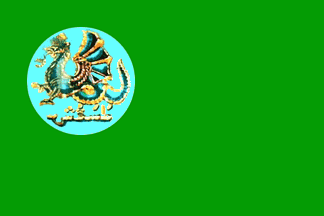 image by António Martins, 11 Jan 2004
image by António Martins, 11 Jan 2004
At www.mi.ru/~ant/antinucl.htm,
there is the flag of Antinuclear society of Tataria.
Jens Pattke, 28 Oct 2001
The flag of the Antinuclear Society of Tataria, in Russian
Антиядерное
Общество
Татарии | Antiâdernoe Obxestvo
Tatarii, is green with its logo placed on the upper hoist.
The logo is a light blue disc with golden and dark blue
wyvern on it, above an inscription in Arabic
script. Approx. dimensions are 1/2 for the logo’s diameter and 3/4 for the
width of the imaginary square where the logo is centered, itself anchored to
the upper hoist, being 1 the flag’s height. Supposed ratio 2:3.
The linked page also shows
a monochrome seal with the same elements and a further version of the name,
in Tatar, but it is too small to read.
António Martins, 11 Jan 2004
There is a better logo at
www.mi.ru/~ant/.
Victor Lomantsov, 02 Nov 2001